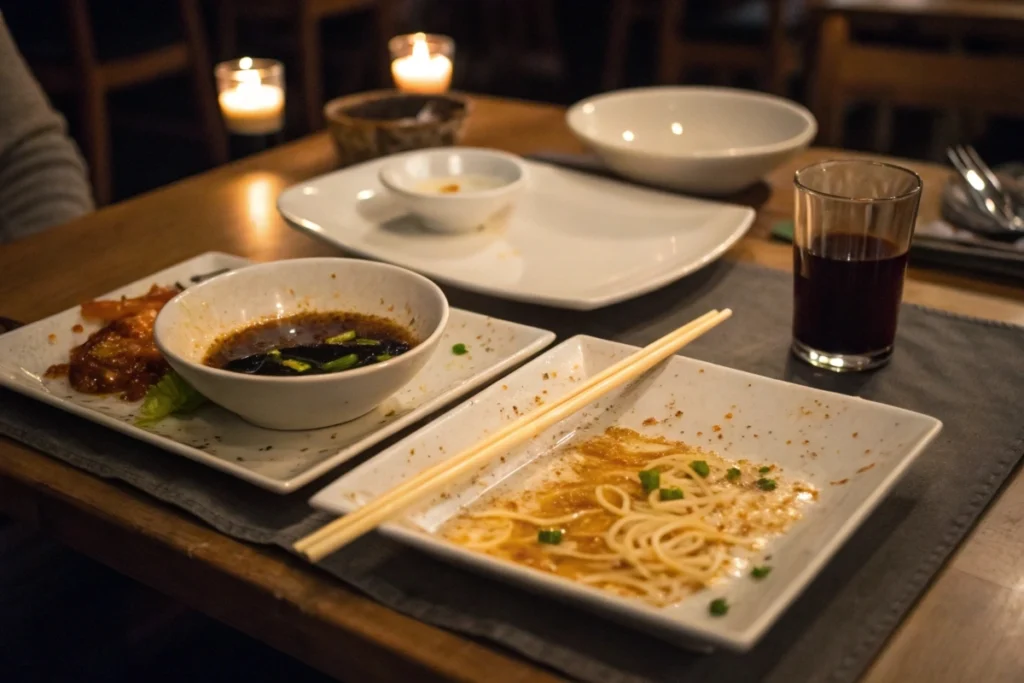Introduction
If you’ve ever typed best Japanese food near me into your phone while traveling or at home, you know the joys and frustrations of sifting through countless listings. Sushi bars, ramen joints, izakayas, fusion cafés—the variety spans coasts and countless culinary styles. With a bit of knowledge and strategic searching, you can uncover hidden gems or confirm the local favorites everyone’s raving about.
This guide will help you navigate the American Japanese food scene, clarifying everything from signature dishes to insider ordering tips. We’ll also discuss how to use SERP analysis or local apps for a more efficient quest, whether you’re craving sushi at midnight or in search of a cozy spot for katsu curry on a chilly evening. By the end, you’ll have the know-how to confidently pick from an array of nice Japanese restaurants near me, no matter your city or state.
For anyone wanting to cook at home, check out our easy-japanese-recipes for approachable, flavorful meals you can whip up. Otherwise, let’s dive into the vibrant world of American Japanese dining, exploring its regional nuances, most beloved plates, and ways to ensure your next meal is the best you’ve ever had.
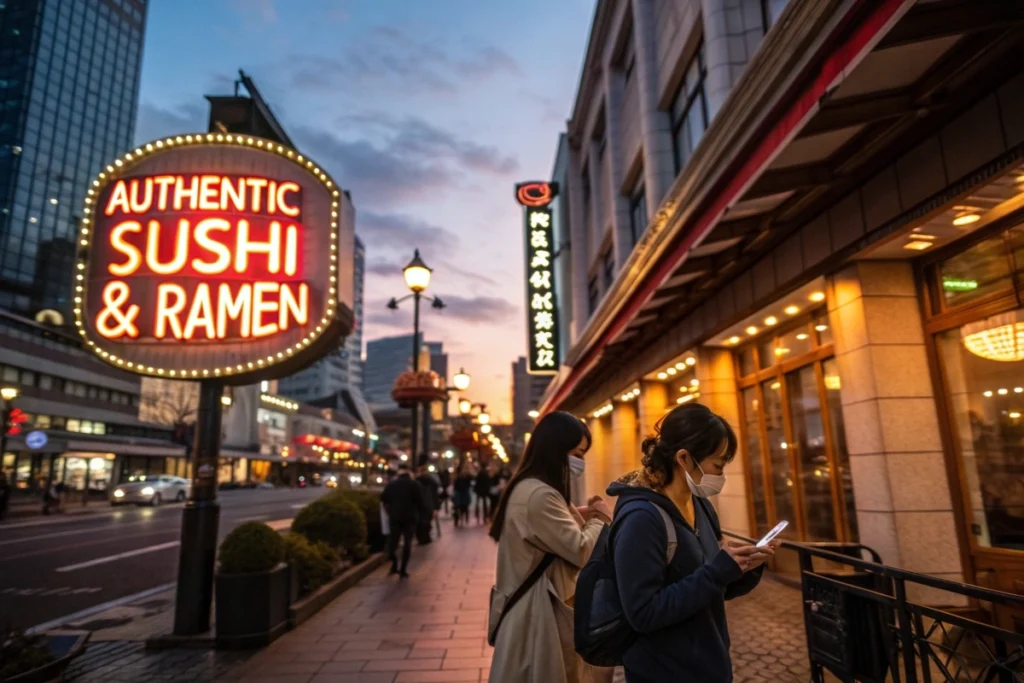
1. Defining Japanese Cuisine in the United States
Japanese cuisine in America is a tapestry of traditional techniques, fusion trends, and local adaptations. As you search for the best Japanese food near me, you’ll notice some places focus on time-honored dishes, while others embrace creativity—like sushi burritos, ramen burgers, or donuts made from mochi dough.
Core Elements of Japanese Food
- Rice: Short-grain rice or sushi rice forms the staple base, found in sushi, donburi bowls, or shaped into onigiri.
- Seafood: The U.S. benefits from vast coastlines, so fresh fish is readily available. Sushi and sashimi remain iconic, though quality hinges on fish handling.
- Noodles: Ramen, udon, soba, and somen—each offering unique textures and flavors. Many shops specialize in a single type, giving you a deep-dive experience.
- Umami Factor: Miso, soy sauce, and bonito flakes deliver that signature savory depth.
Styles of Japanese Dining in the USA
- Casual Sushi Bars: Often found in shopping plazas or near office districts, providing quick rolls or lunch specials.
- High-End Omakase: Chef-driven experiences where each sushi piece is crafted meticulously. These can be pricey, but the quality often justifies the cost.
- Ramen Shops: A more recent surge across American cities, offering thick tonkotsu broths or lighter shio variations.
- Izakayas: Japanese-style pubs with small plates like karaage (fried chicken), yakitori, or gyoza, perfect for group gatherings.
Regional Influences
- Coastal States: Expect abundant seafood; freshness ranks high in sushi or sashimi spots.
- Midwest: Popularity of hearty, warming ramen or fried items, matching colder climates.
- Southern Areas: Some restaurants merge Japanese elements with local barbecue styles or spicier flavors. For a marinade that fuses Eastern-Western tastes, see our japanese-barbecue-sauce-recipes for ideas.
Fusion vs. Authentic
Not all “Japanese” restaurants are fully authentic—some blend Western styles to appeal to broader audiences. Rolls laden with cream cheese or jalapeños, for instance, deviate from classic sushi but remain popular in many American locales. Deciding whether you want purely traditional fare or are open to innovative riffs helps direct your search.
The Rise of Variety
Given the breadth of American tastes, from those who love raw fish to those who only want katsu curry, you’ll find nearly every sub-genre represented. This variety ensures you can find your perfect match, but it also means sifting through possibilities. In the next section, we’ll pinpoint iconic Japanese dishes that appear on U.S. menus—so you know what to order or identify if you’re looking at a menu for the first time.
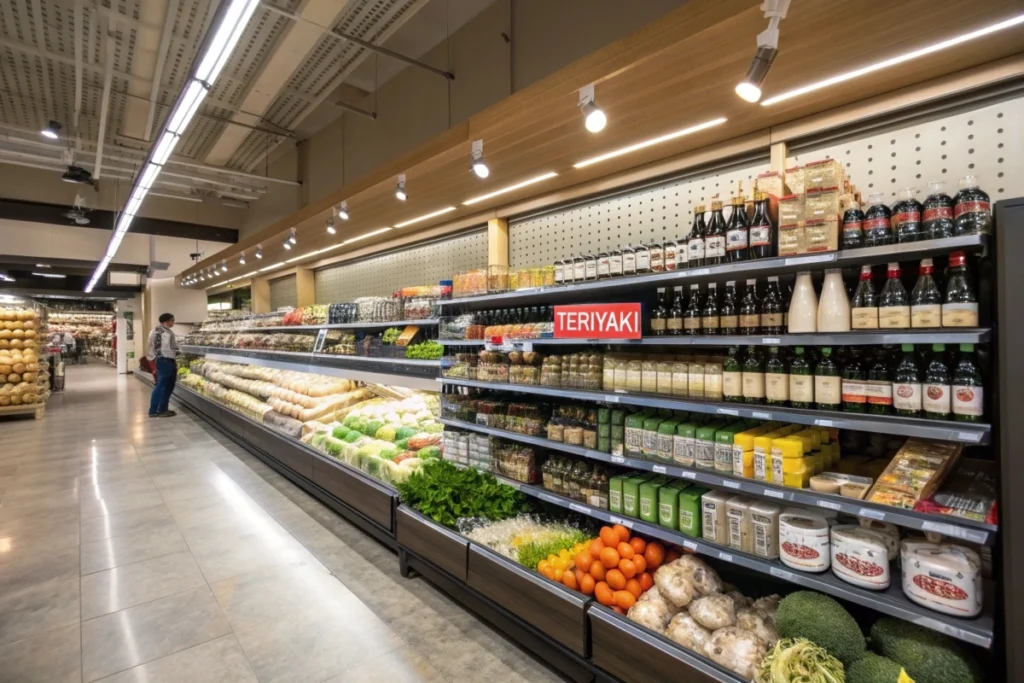
2. Iconic Dishes You’ll Find Stateside
If you’re new to best japanese food near me, discovering the most popular dishes in American Japanese restaurants can clarify your decision-making. Whether you crave comfort or novelty, these classics likely appear in your local spot’s menu.
1. Sushi & Sashimi
- Rolls (Maki): California roll (with avocado and imitation crab) is a prime example of Western adaptation. Others include spicy tuna or dragon rolls.
- Nigiri & Sashimi: For the purist, fresh cuts of fish on vinegared rice (nigiri) or alone (sashimi) highlight quality. If the fish melts in your mouth, you’ve found a good place.
- Dipping: Use minimal soy sauce or try adding wasabi for a spicier kick.
2. Ramen
- Broth Types: Tonkotsu (pork bone) is revered for its creamy richness, miso is savory-sweet, shio is light, and shoyu has a darker soy-based flavor.
- Toppings: Chashu pork, seasoned egg, bamboo shoots, nori, or even corn (common in Hokkaido-style) may appear. If you want to replicate a hearty ramen at home, see japanese-chicken-fried-rice-recipe- for related stir-fry concepts.
3. Tempura
- Batter & Fry: Seafood (shrimp, fish) or veggies (sweet potato, squash) coated in a light batter.
- Dipping Sauce: Typically a mild tentsuyu sauce. Crispness is key—good tempura should never be soggy.
4. Katsu Curry
- Meat Cutlet: Chicken or pork breaded in panko, deep-fried, then served with thick Japanese curry.
- Curry Sauce: Milder and sweeter than many other curries, thickened with roux blocks widely sold in the US.
5. Donburi Bowls
- Katsudon: Fried cutlet over rice with egg and onions.
- Gyudon: Thin-sliced beef simmered in a sweet-savory sauce.
- Oyakodon: Chicken and egg “parent-child” bowl referencing the use of both in one dish.
6. Teriyaki & Yakitori
- Teriyaki: Popular in the US, featuring sweet and savory sauce for grilled chicken, salmon, or beef.
- Yakitori: Skewered chicken pieces grilled over charcoal, sometimes basted with a tare sauce. If you want to see how marinade logic applies, check out authentic-japanese-barbecue-sauce-chicken-recipe-easy-delicious.
7. Tonkatsu
Similar to schnitzel, tonkatsu involves breaded pork cutlet served with shredded cabbage. Often drizzled with a sweet Worcestershire-like sauce, it offers a crunchy-juicy combo.
Desserts
Japanese sweets—mochi ice cream, dorayaki, or matcha-flavored treats—might appear in select places. For a deeper dessert experience, reference traditional-japanese-desserts-recipe to appreciate the sweet side of Japanese cuisine.
Conclusion of Section
Spotting these dishes ensures you won’t miss out on top-sellers. If a restaurant excels in multiple categories—fresh sushi, robust ramen, crispy tempura—that’s a strong indicator it ranks among the best japanese food near me. Up next, we’ll outline practical steps for finding these spots, bridging Google reviews, social media, and word-of-mouth tips in the United States.
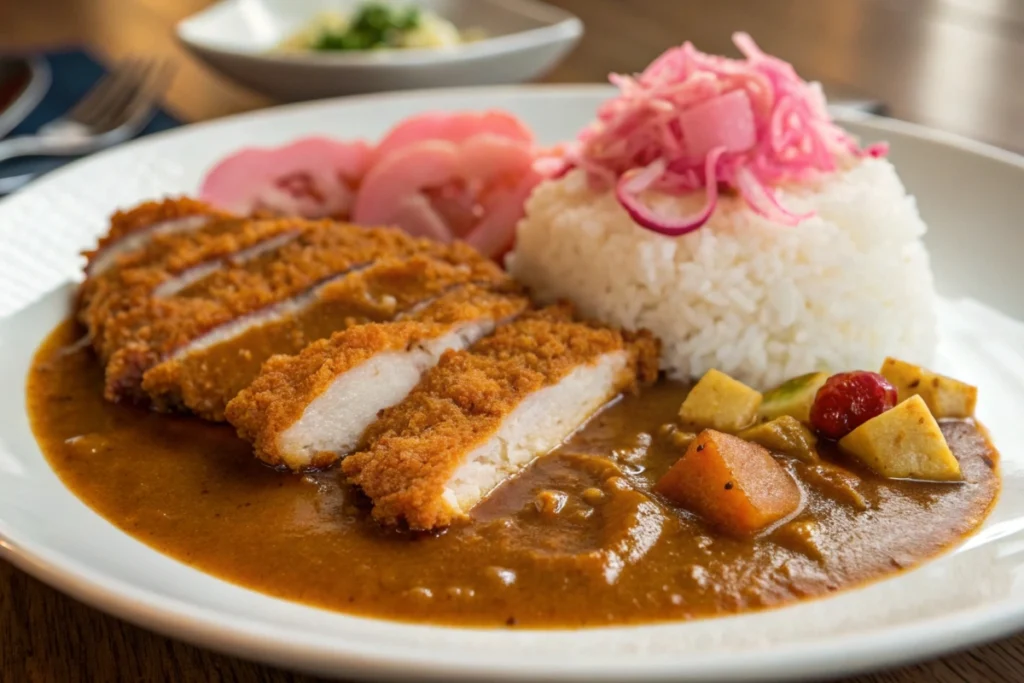
3. Navigating the Best Japanese Restaurants Near Me in the USA
Local Directories & Google Maps
To find best japanese food near me in the United States, you’ll likely start with Google Maps or Yelp. Sorting by rating, distance, and “open now” helps refine your search. Pay special attention to photos and user reviews describing flavor authenticity or mentioning fresh fish shipments. For instance, if multiple reviews praise the “buttery salmon nigiri” or “authentic miso ramen,” that’s promising.
SERP Analysis Tools
Using an SEO or SERP analysis tool, input “best japanese food near me.” The top 10 results often feature localized aggregator websites, big name review platforms, or official restaurant pages. Compare headings to glean popular terms: is everyone highlighting sushi and ramen, or do you see mention of udon or omakase? This can highlight local demand. You might even spot less common items like unagi-don or kaiseki sets, pinpointing which restaurants attempt regional diversity.
Reviews & Ratings
- Detailed vs. Generic Reviews: Look for long-form feedback about taste, service, and cleanliness, not just star counts.
- User-Posted Photos: Visual evidence of portion sizes, plating, or how fresh the fish looks.
- Menu Snapshots: Some reviewers upload entire menu pages, letting you spot seasonal or unique dishes.
Social Media & Community Groups
Instagram hashtags like #japanesefood + your city name can yield real-time visuals. Alternatively, local foodie Facebook groups or Reddit subforums (e.g., /r/food, /r/YourCityName) might share hidden gems. This approach often uncovers family-owned restaurants overshadowed by big marketing budgets.
Word-of-Mouth
In the US, many robust Japanese communities exist—be it in West Coast enclaves or East Coast hubs. Ask Japanese-American friends or diaspora communities for personal favorites. They likely know who imports specific ingredients or which chef studied in Tokyo. For celiac or vegan queries, specific groups can direct you to restaurants with dedicated GF or plant-based menus.
Call Ahead
If a place ranks well but you have particular preferences—like GF sauce or a love for uni (sea urchin)—call to confirm availability. Many restaurants in the US update menus seasonally or rely on daily shipments. This ensures you don’t arrive only to find your desired item out of stock.
Balancing Convenience & Authenticity
Downtown areas often boast quick grab-and-go sushi or lunch specials. Suburban spots might be more spacious, focusing on dinner service with elaborately plated meals. Decide if you want fast or leisurely dining. If you’re after a relaxed feast, see steak-japanese-recipe for a marinade reminiscent of some teppanyaki flavors you might find in a suburban Japanese steakhouse.
4. Japanese Takeout and Quick Bites
Rise of Takeout Culture
Post-pandemic, many American Japanese eateries upgraded their takeout game. From sushi combos to bento boxes, convenience soared. Searching “japanese take out food near me” yields a spectrum: some offer specialized packaging to keep tempura crisp or ramen noodles separate from broth.
Top Takeout Picks
- Makizushi Rolls: Cooked or veggie rolls hold up well if you can’t eat immediately.
- Donburi Bowls: Rice-based items with toppings usually stay tasty even after a short commute.
- Bento Boxes: Perfectly compartmentalized, combining protein, rice, and sides.
- Teriyaki/Grilled Proteins: Chicken or beef teriyaki travels well if sauce and meat remain separate.
Watch Out For
- Soggy Tempura: Fried items can steam in the box. Some restaurants poke ventilation holes or use special containers.
- Ramen & Udon: Best if broth and noodles come separately. Confirm that’s how your local spot does it.
- Sauce Spillage: Sushi soy sauce containers sometimes leak. Double-check secure packaging.
Quality Indicators
Look for places that mention “takeout-friendly packaging” or have positive reviews specifically referencing carryout. For instance, a reviewer might detail how their ramen arrived with separate components or how sushi remained fresh upon arrival. If you plan to replicate a side dish at home—like a veggie stir-fry—see vegetables-japanese-recipe for guidance.
Drive-Thru and Quick-Service Concepts
Some modern “fast-casual” Japanese concepts operate like American burger joints. You might see drive-thru lines for sushi burritos or poke bowls. While purists might question authenticity, these spots often fill the niche for a quick lunch. If they maintain fresh fish rotation and sauce quality, they can still be considered among the best japanese food near me for a speedy fix.
Balancing Time & Quality
If you’re short on time but want a decent meal, consider how well each dish travels. A piping-hot miso soup might not hold up during a 30-minute commute, but a sushi roll with a chilled pack might. If your local Japanese eatery closes after lunch, plan accordingly or confirm if they run dinner hours. In the next section, we’ll delve into ordering tips and menu decoding, ensuring your experience—be it dine-in or takeout—hits the mark every time.
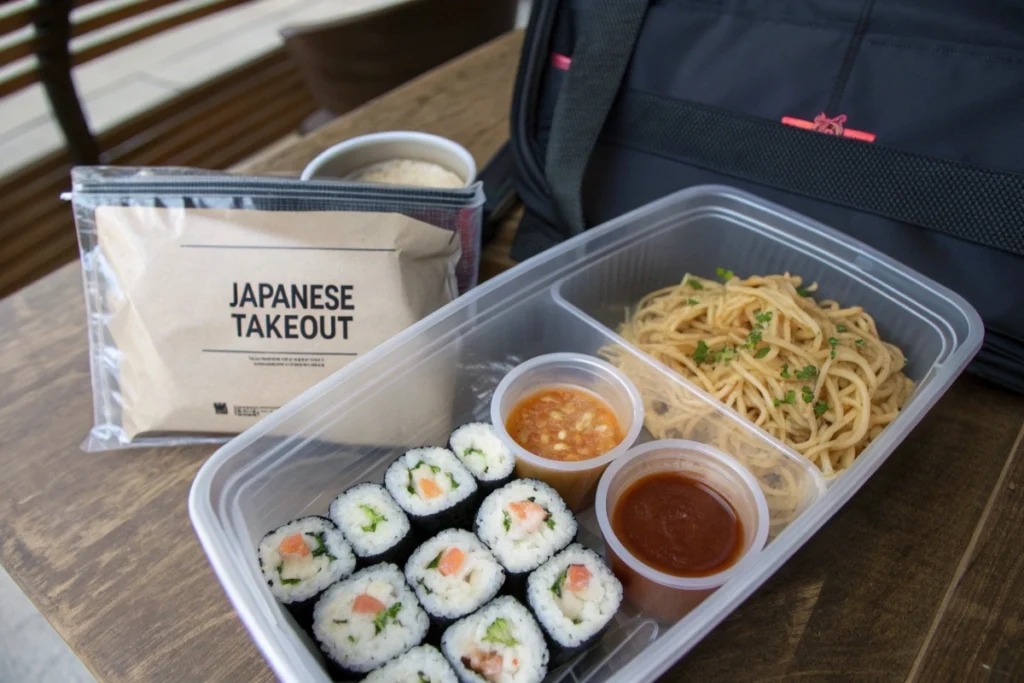
5. Ordering Tips and Menu Insights
Reading Menus Like a Pro
If you spot unknown terms, politely ask the server or do a quick search on your phone. For instance, “shio koji marinade” might appear. This fermented marinade adds umami to meats—worth trying if you see it. Understanding these lesser-known elements can upgrade your meal from standard fare to culinary adventure. If you can’t decide, consider minced-beef-japanese-recipe for a home adaptation if ground beef or special marinade catches your eye in a restaurant’s offerings.
Dialing in Heat & Flavor
While classic Japanese cooking isn’t typically spicy, many American spots cater to bolder palates, offering chili or sriracha-infused rolls. If that’s your preference, look for the spice symbol or ask if the ramen can be spiced up. Conversely, if you prefer milder tastes, confirm you’re ordering a standard miso or shoyu base minus extra chili.
Staying Seasonal
In the US, top-tier Japanese restaurants often sync with Japan’s seasonal ethos. If you visit in spring, you might see cherry blossom-themed sweets or fresh bamboo shoots. In fall, sweet potato or chestnut might appear in desserts or side dishes. Asking about seasonal specials reveals the chef’s focus on freshness.
Greeting & Etiquette
Many staff welcome you with “Irasshaimase!” responding with a smile or nod suffices. After your meal, “Gochisousama deshita” is the polite Japanese phrase to show appreciation, though an English “Thank you, it was wonderful” works just as well. If you’re intrigued by cultural background on mealtime traditions, see japanese-new-year-recipes for a deep dive into holiday norms.
Planning for Wait Times or Reservations
Popular sushi bars or specialty ramen shops can see lines out the door—especially on weekends. If it’s a well-rated place near a business district, consider peak lunch rush times. For omakase-style or teppanyaki experiences, booking a reservation ensures you get a seat. If you see multiple reviewers mention “long wait but worth it,” plan accordingly or aim for off-peak dining hours.
Payment & Tipping
In America, tipping between 15-20% remains customary if you have table service. At fast-casual or takeout counters, tipping is optional but appreciated if you notice exceptional care in packaging or custom meal prep. Some higher-end Japanese restaurants automatically add gratuity for large parties. Always check the bill.
By leveraging these tips—menu decoding, seasoning preferences, seasonal hunts, and mindful etiquette—you’ll maximize the satisfaction from your best japanese food near me hunt. Next, we’ll present a historical overview of how Japanese cuisine rooted itself in the American dining landscape, plus examples illustrating how chefs and diners shaped the scene.
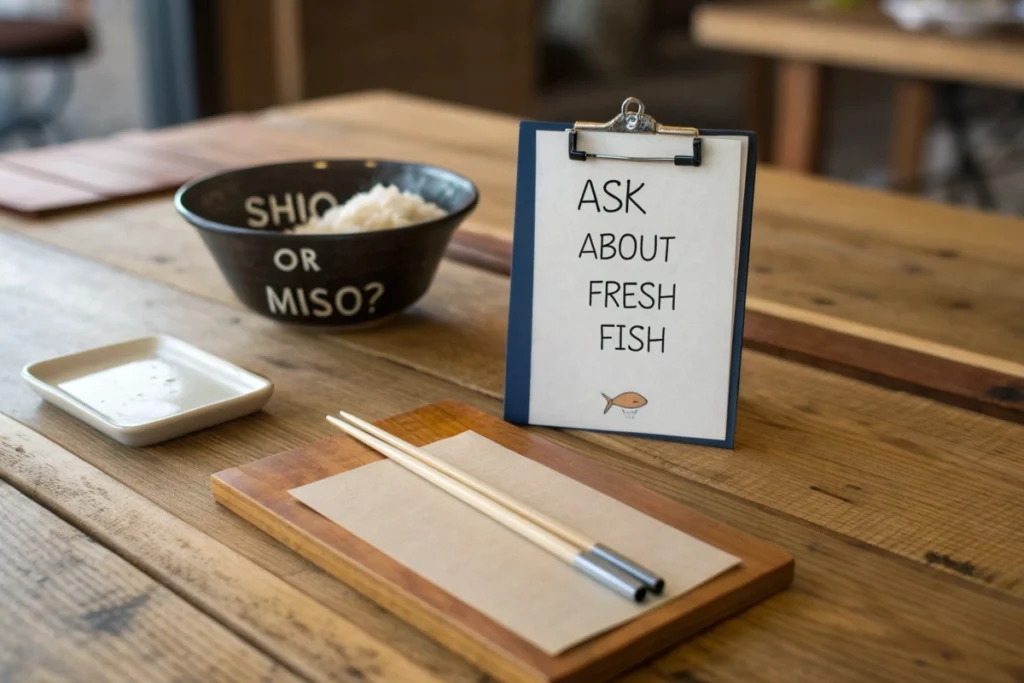
History and Examples
The Evolution of Japanese Cuisine in America
Post-World War II, Japanese immigrants and returning U.S. servicemen introduced sushi and ramen stateside. California’s West Coast quickly became a hub for Japanese eateries, culminating in the popularization of sushi in the 1960s and 1970s. Meanwhile, ramen’s global popularity soared in the 2000s, boosting instant ramen sales and prompting specialized shops to open in many American cities.
The Sushi Boom
Chefs like Nobu Matsuhisa gained fame, blending traditional Edomae sushi with Peruvian or Californian influences. Rolls featuring avocado, cream cheese, or spicy mayonnaise soon emerged, satisfying American palates. This creative synergy made sushi accessible and mainstream. For a nod to tradition amid these modern twists, check japanese-food-sushi-history for insights into how sushi evolved from an ancient preservation method to a global phenomenon.
Ramen Renaissance
Once overshadowed by sushi mania, ramen rose to stardom around the 2010s. Authentic shops, focusing on precise broth simmering and fresh noodles, sprouted across major U.S. cities. Lines formed outside tonkotsu powerhouses, while “ramen festivals” drew thousands. Meanwhile, instant ramen fans discovered artisanal versions, bridging convenience with gourmet quality.
Adaptations and Fusion
Restaurants often adapted flavors for local tastes—like teriyaki-laden burritos or matcha-lattes with whipped cream. Some Japanese chefs embraced this fusion, while purists opened smaller “hidden gem” joints emphasizing ancestral recipes. Over time, celiac-friendly versions, vegetarian broths, and vegan sushi expanded inclusivity.
Community and Cultural Awareness
As more Americans visited Japan or learned about its traditions via anime or pop culture, interest in authentic tastes grew. Local “Japan festivals,” anime conventions, and cooking classes further spread awareness, fueling demand for genuine fish stocks, homemade miso, and specialty ingredients. If you’re keen on re-creating a well-loved dish at home, see japanese-old-fashioned-recipe for a mix of Western cocktail style with Japanese flair—exemplifying cross-cultural blending.
By combining ancient cooking techniques with modern innovation and flexible menus, Japanese cuisine in the U.S. continues evolving. It’s not just about sushi and ramen—tempura, yakitori, and wagyu steak also flourish. Understanding this journey heightens appreciation for the complexity behind each bowl of broth or delicately rolled sushi. Next, let’s examine practical scenarios that highlight how different diners find and enjoy the best japanese food near me across America.
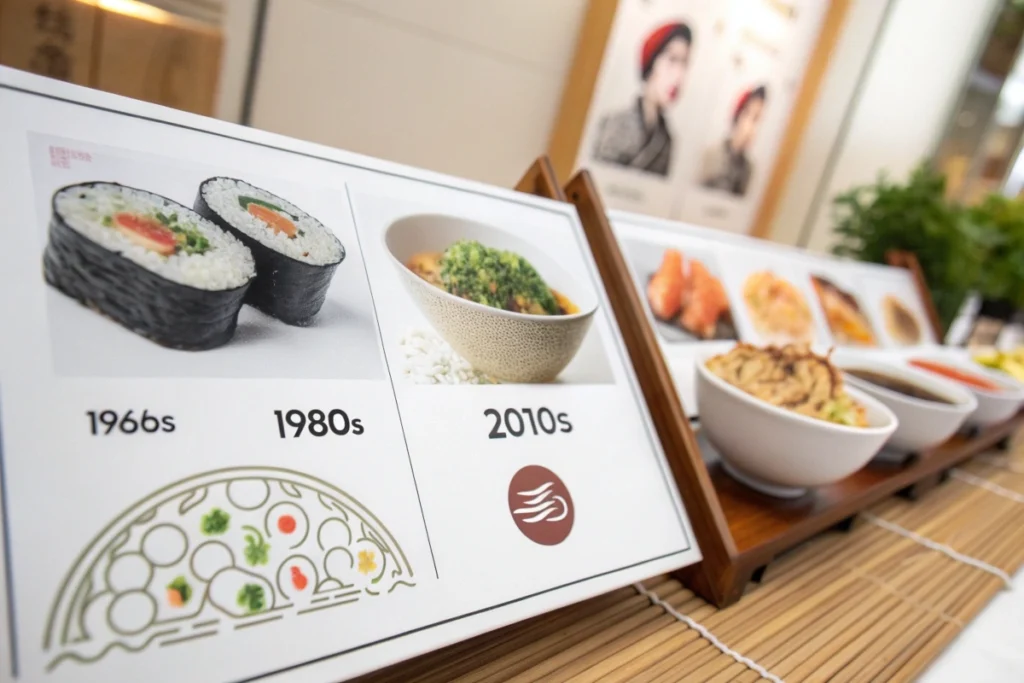
Practical Examples/Use Cases
- Busy Professional Grabbing Lunch
Sarah, a corporate worker in Chicago, only has 30 minutes for lunch. She quickly Googles “best japanese food near me open now.” The top result is a fast-casual donburi shop. She orders a teriyaki chicken bowl, finding it arrives quickly, tastes balanced, and fits her time window. She adds the place to her favorites, impressed by the mix of speed and quality. - Family Weekend Dinner
The Lopez family wants to expose their kids to broader flavors. They choose a local sushi-and-ramen restaurant well-reviewed by families. Their kids enjoy child-friendly rolls (like an avocado roll), while the parents savor spicy miso ramen. Everyone shares a few tempura veggies. A friendly server helps them navigate the menu, explaining cultural notes. This fosters curiosity and appreciation for Japanese dining. - Health-Conscious Eater on a Budget
Mark aims for clean-eating but loves bold flavors. Searching “japanese places near me,” he lands on a bento café offering grilled salmon with brown rice and steamed vegetables. For an under-$15 meal, he gets high protein, minimal oil, and a tangy side of pickles. He also references minced-beef-japanese-recipe at home for future meal prep, excited to incorporate more Japanese-style marinating. - Traveling Foodie
Dylan, a traveling foodie passing through Los Angeles, uses a SERP tool to find the top ramen shops. He zeroes in on a spot lauded for a 20-hour pork bone broth. He arrives early to avoid lines, sips the creamy soup, and declares it among his top meals. Inspired, he checks out japanese-curry-recipe-one-piece to replicate a comfort dish once he’s back home.
Exploring the Diversity of Japanese Cuisine
These scenarios highlight how diverse Americans—be they on strict schedules, families exploring new tastes, budget-minded eaters, or traveling gourmands—can pinpoint the best japanese food near me. Next up, we’ll address frequently asked questions about must-try dishes, common greetings, and how to choose standouts on any given menu.
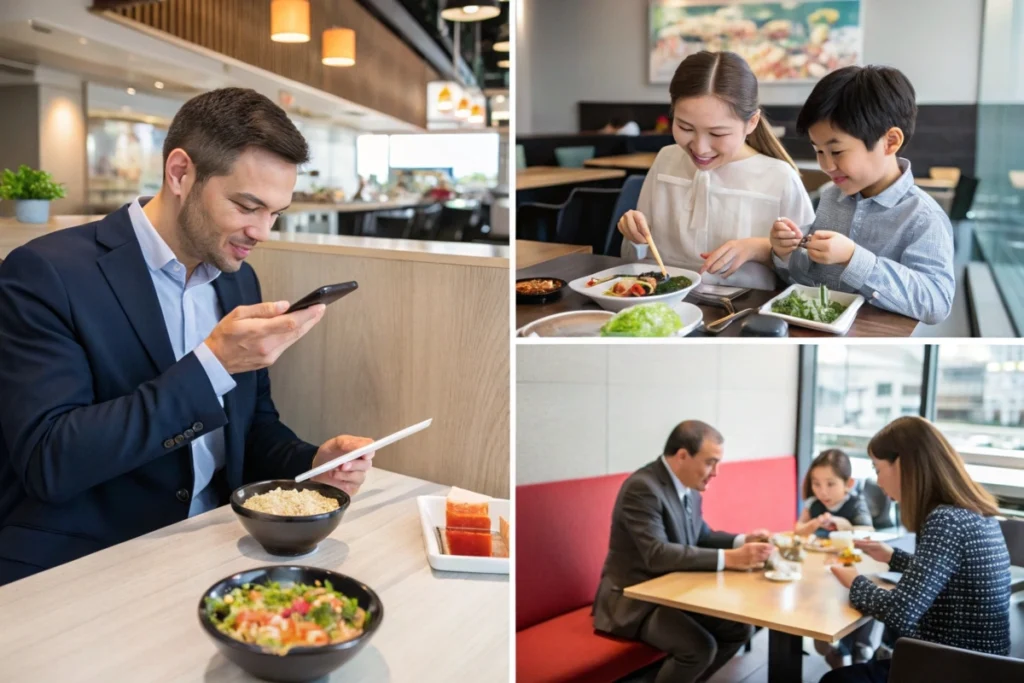
FAQs
Q1: What is Japan’s number 1 food?
Many argue sushi is Japan’s top culinary icon. However, ramen and katsudon remain strong contenders. The preference depends on personal taste, regional influences, and global recognition—sushi typically emerges as the most internationally famous.
Q2: What is the most popular Japanese dish?
Sushi stands out as the go-to dish worldwide, but ramen has gained explosive popularity for its comfort and variety. In the United States, both sushi and ramen dominate Japanese restaurant menus, while curry, tempura, and udon also hold dedicated fanbases.
Q3: What do you say when you walk into a Japanese restaurant?
The staff usually greets you with “Irasshaimase,” meaning “Welcome!” You can smile, nod, or say “Hello!” In Japan, some diners might softly respond “yoroshiku onegai shimasu,” but in the U.S., a friendly acknowledgment suffices.
Q4: What is the best thing to eat at a Japanese restaurant?
It depends on your palate. Sushi lovers might choose omakase (chef’s selection), ramen fans seek their favorite broth (tonkotsu, miso, or shoyu), and comfort seekers might opt for katsu curry. If you’re open to recommendations, ask the staff about house specialties or fresh imports.
Q5: How do I find the best Japanese restaurants near me in the US?
Use local review apps (Yelp, Google Maps), check user photos, read detailed reviews, and look out for specialties. SERP analysis reveals top 10 results in your area. For dietary concerns—like gluten-free—call ahead or see gluten-free-japanese-food for tips on safe sauce substitutions.
Q6: Any cultural tips for dining in a U.S. Japanese restaurant?
Try using chopsticks if comfortable, or request a fork if needed—staff won’t mind. When done, place chopsticks neatly on a rest or across your bowl. Tipping 15-20% is standard in the U.S. if you had table service.
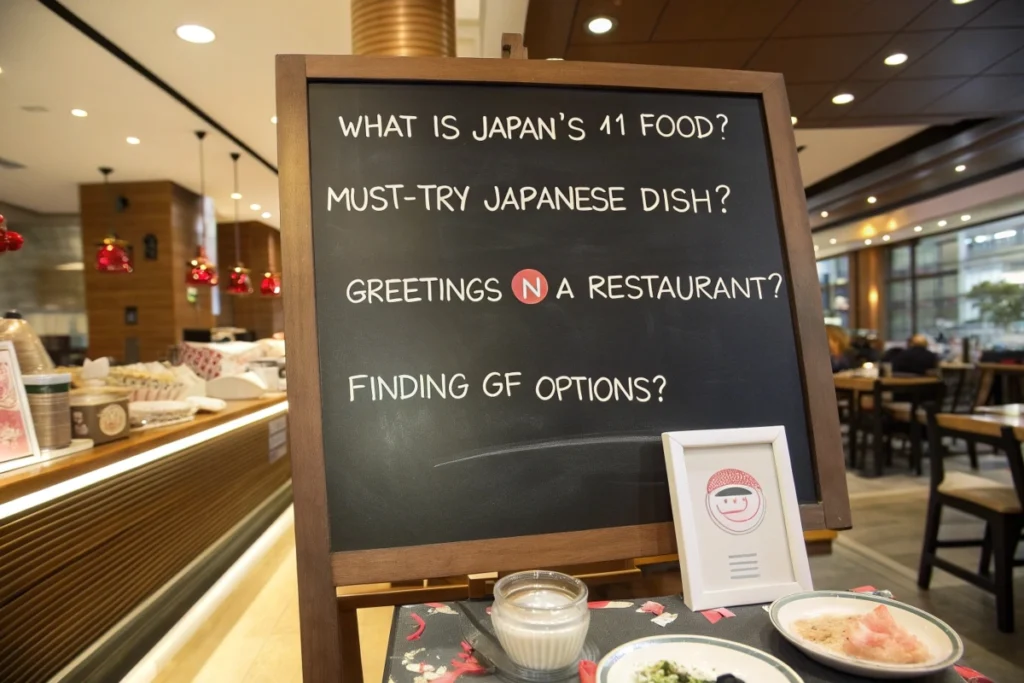
Conclusion
Unearthing the best Japanese food near me in the United States involves blending local insights, SERP analysis, and a willingness to explore. By noting key menu items—sushi, ramen, donburi, tempura—you’ll recognize authenticity and appreciate nuanced flavors. Social media, word-of-mouth, and review platforms help pinpoint standouts, while an understanding of how these dishes have journeyed from Japan to the U.S. fosters deeper cultural appreciation.
Whether you’re a busy professional craving takeout, a family seeking a new weekend favorite, or a traveling foodie chasing top-rated omakase, the American Japanese dining landscape provides endless variety. Embrace traditional spots for heritage cooking or dabble in modern fusion. Keep an eye on seasonal specials for unique tastes, and don’t hesitate to ask for dietary adjustments—restaurants now often accommodate gluten-free or vegetarian lifestyles.
Ready to push your experience further? Try re-creating some favorites at home with resources like japanese-sweets-recipes, bridging the gap between restaurant indulgence and homey comfort. Above all, savor each moment—both the meal and the cultural journey—knowing you’re part of an ever-evolving story of Japanese cuisine in the United States.
